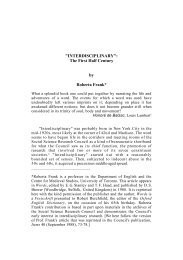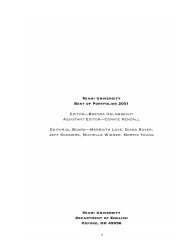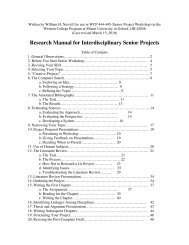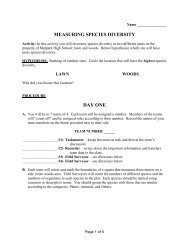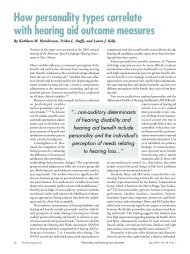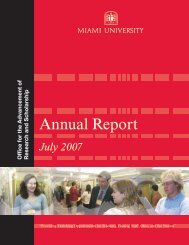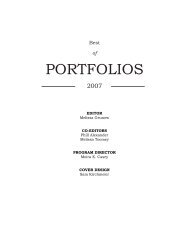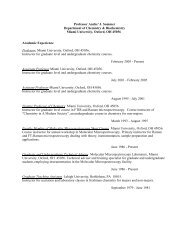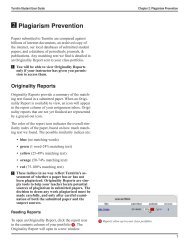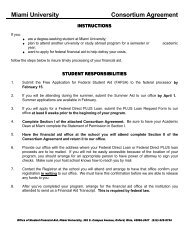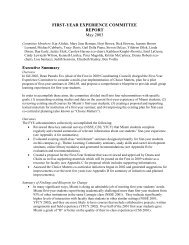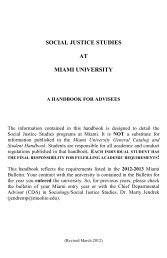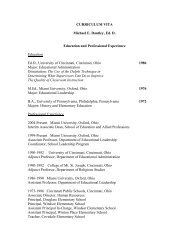The Steppes: Crucible of Eurasia - units.muohio.edu - Miami University
The Steppes: Crucible of Eurasia - units.muohio.edu - Miami University
The Steppes: Crucible of Eurasia - units.muohio.edu - Miami University
Create successful ePaper yourself
Turn your PDF publications into a flip-book with our unique Google optimized e-Paper software.
effects upon the geopolitics <strong>of</strong> the time. It is not an accident that the Tuyuhun land fell into the<br />
rising Tibetan empire from the 630s. <strong>The</strong>refore, Tuyuhun and Tibet could be added to Barfield’s<br />
analysis as another key ecological and cultural area that played an important role from the early<br />
seventh centuries onwards in China’s frontier relations with Inner Asia.<br />
Daniel Prior, Department <strong>of</strong> History, <strong>Miami</strong> <strong>University</strong> (priordg@<strong>muohio</strong>.<strong>edu</strong>)<br />
Integral or Incidental? Indo-European Mythic Fragments in Inner Asia<br />
In this paper I trace and seek to explain a number <strong>of</strong> thematic parallels between a midnineteenth<br />
century oral epic poem <strong>of</strong> the Kirghiz, entitled Joloy Qan, and two seemingly<br />
unrelated symbolic phenomena: a Hsiung-nu–era Siberian figurative bronze belt buckle plaque<br />
from the Arthur M. Sackler Collections, and a diverse set <strong>of</strong> mythic themes from a broad range<br />
<strong>of</strong> ancient Indo-European traditions. Judging the soundness <strong>of</strong> these correspondences is a matter<br />
<strong>of</strong> methodological and theoretical interest, as they involve ethnolinguistic diversities and spans<br />
<strong>of</strong> time and space on scales that push the bounds <strong>of</strong> plausible reconstruction. <strong>The</strong> movements <strong>of</strong><br />
peoples and ideas suggested by these correspondences conform to some models <strong>of</strong> Inner Asian<br />
prehistory while challenging others.<br />
<strong>The</strong> three items under comparison display “exquisite correspondences,” thematic<br />
parallels the number and narrative precision <strong>of</strong> which would seem to demand some kind <strong>of</strong><br />
explanation besides pure chance. A hero/god figure who is guilty <strong>of</strong> kin killing, breach <strong>of</strong> oath,<br />
and sexual transgressions, goes berserk and kills his own warriors, and decapitates an enemy; his<br />
sister has a sexual liaison with an enemy, and is dragged to death by horses; a young hero/god<br />
(the aforementioned one or his son) is born <strong>of</strong> the waters, has nine joint parents who are siblings,<br />
has sword- and sheep/goat-associations, and lacks a wife: these themes are found in Joloy Qan<br />
and in dispersed remnant form in Norse (Germanic), Roman (Italic), Vedic (Indo-Aryan),<br />
Ossetic (Iranian), and Nuristani (Dardic/Indo-Iranian) traditions. <strong>The</strong> young hero/god, who has a<br />
relationship with a hawk–spirit-maiden, transports his elders in a cart to a land <strong>of</strong> everlasting<br />
happiness: these themes are found in Joloy Qan and the Hsiung-nu belt buckle.<br />
Although the composition <strong>of</strong> the recent Kirghiz epic Joloy Qan is a process about which<br />
very little is known, it seems that some elements <strong>of</strong> the story preserve very ancient narrative<br />
complexes that have elsewhere been scattered almost beyond recognition.<br />
Leland Rogers, Department <strong>of</strong> Anthropology, Indiana <strong>University</strong> (lelroger@indiana.<strong>edu</strong>)<br />
Ancient DNA from the Elite Xiongnu at Ögiinuur Sum, Arkhangai, Mongolia<br />
It has been fairly well established that the Bronze Age inhabitants <strong>of</strong> the Hangai<br />
mountain range in Mongolia were predominantly “Europoid”; the Xiongnu population shows a<br />
substantial mixing. Nine Xiongnu period ancient bone samples from Elite Xiongnu period<br />
burials at Ögiinuur Sum, Arkhangai, have had preliminary testing <strong>of</strong> the HVS 1 region <strong>of</strong> their<br />
mitochondrial DNA. Seven <strong>of</strong> the samples have produced some results. While all the results<br />
must be confirmed, results suggest a higher proportion <strong>of</strong> “Europoid” markers than expected.<br />
<strong>The</strong> region <strong>of</strong> study was chosen due to its relative proximity to the ancient Mongol and Uyghur<br />
capitals, along with its relative proximity to known burials <strong>of</strong> the Xiongnu imperial house. This<br />
is a work in progress <strong>of</strong> 44 Xiongnu period samples from the southeast Hangai range granted by<br />
the National <strong>University</strong> <strong>of</strong> Mongolia.<br />
11



